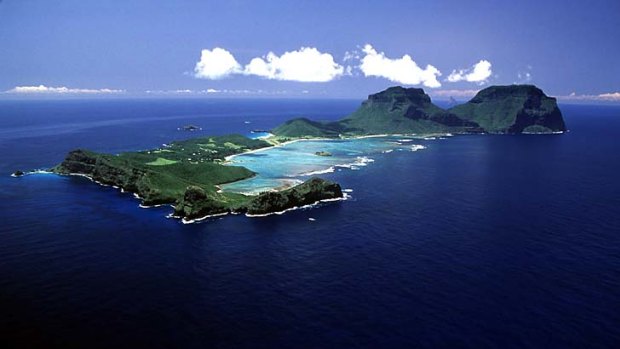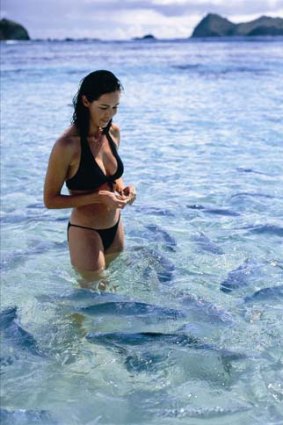This was published 12 years ago
Howe wonderful: it's paradise and it's ours

Howe beautiful ... Lord Howe island.
City dweller Leah McLennan finds paradise just two hours from Sydney.
Is that me squealing with excitement? A second squeal confirms it.
Out the plane window there's a fairy-tale creation of jagged volcanic peaks encircled by robin egg blue water.
The pilot does an extra doughnut in the sky just to show off the landscape before landing - there can't be too many destinations that attract this treat by QantasLink.
I left Sydney two hours ago as a wound-up city dweller and within minutes of spotting the cows munching on spinach-green grass in the paddock next to the runway I instantly feel less stressed, like I've just had a massage.
I'm travelling alone on this short Lord Howe Island jaunt, but now that I'm here on this Tahiti-esque island I wish I'd brought my husband and daughter with me.

To-do list ... feeding the fish at Neds Beach - a protected marine zone.
At the airport terminal, which is nothing more than a shed with a computer, I'm met by manager Dani from Pinetrees, the oldest of the island's resorts.
On the short drive to the retreat, Dani points out along the way places with delightful names like Lovers Bay and Lagoon Beach.
The population of Lord Howe, she explains, is about 350 and visitor numbers are capped at 400.
The speed limit is 25km/h, everyone rides bikes and there are honesty boxes everywhere - "at the boatshed just put the money in the tin and help yourself to a drink, at Neds Beach the masks, fins and snorkels are in the shed and at the nine-hole golf course help yourself to the equipment".
There is little to fear on the island, Dani continues, as there are hardly any spiders and no snakes.
"And no crime," she adds.
"But we do have a policeman and he's very strict on making people wear bike helmets."
There are no keys, no TVs, no mobile coverage and internet access is slow, she warns as we pull into the driveway of Pinetrees.
Dani, with baby Pixie in her arms, shows me to my one-bedroom cottage.
The accommodation is motel-style basic but it's far from bland. It's clean and comfortable and fresh frangipani flowers have been placed on the bed, kitchen table and bathroom sink.
The only items that shatter the illusion that I've stepped into a time warp are the Nespresso coffee maker and iPod docking station.
I crank up the coffee machine, put on some summer music and suddenly I'm in the perfect beach-hideaway.
After unpacking, I jump on my bike - parked at my very own stand outside the front door - and cruise past a sign warning of woodhens on the road.
Even the endemic woodhens are chilled-out on Lord Howe Island.
These bantum-sized birds only break into a run when you're about to ride into them, and they gave up flying years ago.
If you lived in paradise with no predators and plenty of food would you bother with such unnecessary exertion?
Homosapiens, like the wildlife on this World Heritage listed-isle, have also adapted their behaviour to suit the unique environment.
They smile more, wave at strangers and converse excitedly as if intoxicated by the pure air, the unsullied landscape and the talcum-white sand.
Zooming down the road I nearly expect to hear my grandma telling me to slow down and be sensible.
"But I can't slow down, grandma," I want to yell, "I only have two days here".
On my to-do list is: swim with turtles, climb Mt Gower, feed the fish at Neds Beach - a protected marine zone - and discover the world's most southerly coral reef.
At the beach there are a number of brightly-painted sheds with signs out the front advertising kayaks for hire and glass bottom boat tours.
Relaxed Peter from Islander Cruises takes me out on a turtle-watching safari and we spot Sumo, a green turtle measuring 1.3 metres, and his friends Silky and Tripod (he lost a leg).
We potter about under a polished blue sky, looking at butterflyfish, vibrant wrasse and lizardfish darting about in the aquarium-clear water.
Soon it's time to ride back to Pinetrees, where I have a table booked for one.
All meals are included in the Pinetrees rate - breakfast is a buffet, you can either eat in for lunch or take a picnic hamper and there are also barbecue and seafood nights.
The chef's menu is impressive and tonight there's a choice of just-caught Lord Howe yellow fin tuna with crab, cucumber and horseradish salad or roast chicken breast with taleggio polenta cake, spinach and oregano jus.
The accommodation, like the island itself, is delightfully simple but the food could rival any five-star hotel.
Before retiring to my room I make a call from the resort's phone box.
Having not used a pay phone for some time my 40 cents doesn't last as long as expected - "I'm here, it's great, I saw a three-legged ..." is all I could say before the call cuts out.
Back in the room I find a book about Lord Howe and learn the island was first spotted in 1788 by Lt Henry Lidgbird Ball, commander of HMS Supply.
Ball named the uninhabited island after British Admiral Richard Howe.
I fall asleep reading the chapter on woodhens, which were treated rather badly by the British.
"A curious bird walking totally fearless and unconcerned in all part around us, so we had nothing more to do than to standstill a minute or two and knock down as many as we pleased with a short stick," Surgeon Arthur Bowes Smyth wrote when the Lady Penrhyn stopped at Lord Howe in 1788.
Thank goodness there are so many more genial things to do in paradise nowadays.
The writer was a guest of Destination NSW.
FAST FACTS
Lord Howe Island is 600km east of mainland Australia, less than a two-hour flight from Sydney or Brisbane. The island is 11km long and 2km wide. There's a resident population of 350 and a visitor limit of just 400 at any time. In 1982 Lord Howe became the first Australian island to receive World Heritage-listed status. There are no high-rise developments and the 18 accommodation options are almost all owned by island families.
GETTING THERE
QantasLink is the only airline that flies to Lord Howe. It offers daily flights from Sydney and Brisbane and a seasonal weekly service from Port Macquarie (February to June; September to December). The weight limit on Lord Howe flights is 14kg per person of checked baggage and 4kg of carry-on baggage.
WHEN TO GO
Anytime. Lord Howe's climate is mild, year-round. Maximum temperatures on the island hover around 25 degrees Celsius during summer, dipping to an average of 19 degrees in winter.
STAYING THERE
Pinetrees is a resort hotel located in grounds studded with magnificent pine trees. It has ensuite rooms and one, three and four bedroom cottages. Rates from $384 a person twin share, includes all meals, airport transfers. More: www.pinetrees.com.au
Arajilla is a luxury retreat and spa nestled under a canopy of Kentia palms. It has ensuite rooms and one and two bedroom suites. Rates from $595 a person twin share, includes all meals, airport transfers. More: www.lordhowe.com.au
Capella Lodge is Lord Howe's premium boutique accommodation. It has nine suites and a super premium Lidgbird Pavilion with a plunge pool. The lodge commands spectacular ocean and mountain views. Rates from $650 a person twin share, includes breakfast, sunset drinks and canapes, dinner, airport transfers. More: www.lordhowe.com
TOURING THERE
Islander Cruises offer a range of tours. The glass bottom boat turtle tour is $55 for adults, $25 for children. Book at the boatshed or email islander@reachnet.com.au
SWITCH OFF
There is no mobile phone coverage on Lord Howe Island.
MORE INFORMATION
Sign up for the Traveller Deals newsletter
Get exclusive travel deals delivered straight to your inbox. Sign up now.